The Trust Revolution: How B2B Organizations Are Leveraging Video and Influencer Marketing to Drive Growth
August 18, 2025
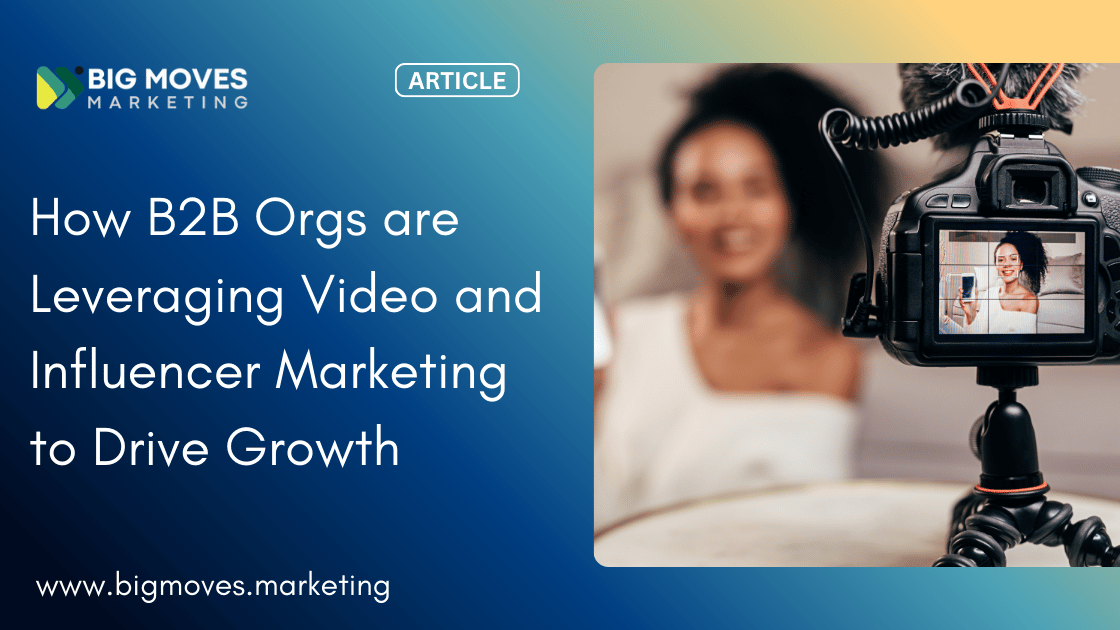
The Trust Revolution: How B2B Organizations Are Leveraging Video and Influencer Marketing to Drive Growth
The modern B2B buying process has fundamentally transformed. Gone are the days when decision-makers followed linear paths from awareness to purchase. Today's business buyers navigate complex, multi-stakeholder journeys filled with private conversations, peer consultations, and extensive research across multiple touchpoints.
According to groundbreaking research from LinkedIn and Ipsos, trust has emerged as the dominant factor driving B2B marketing success, with 94% of marketing professionals agreeing that building trust represents the most important element for achieving brand success. This shift coincides with explosive growth in video adoption, now reaching 78% of B2B marketers, while 55% leverage influencer partnerships to build credibility and drive measurable business outcomes.
The implications extend far beyond marketing tactics. Trust now functions as what researchers term "the routing layer of B2B," determining which organizations gain consideration within private decision-making conversations that occur outside trackable marketing interactions. This transformation requires marketers to rethink fundamental approaches to demand generation, content strategy, and performance measurement.
The Trust Imperative: Why Traditional B2B Marketing Falls Short
The 2025 B2B Marketing Benchmark study, conducted between March 7 and April 7, 2025, surveyed 1,500 participants across six countries to examine how video content and influencer partnerships drive measurable business outcomes. The research reveals a critical disconnect between traditional marketing approaches and contemporary buying behavior.
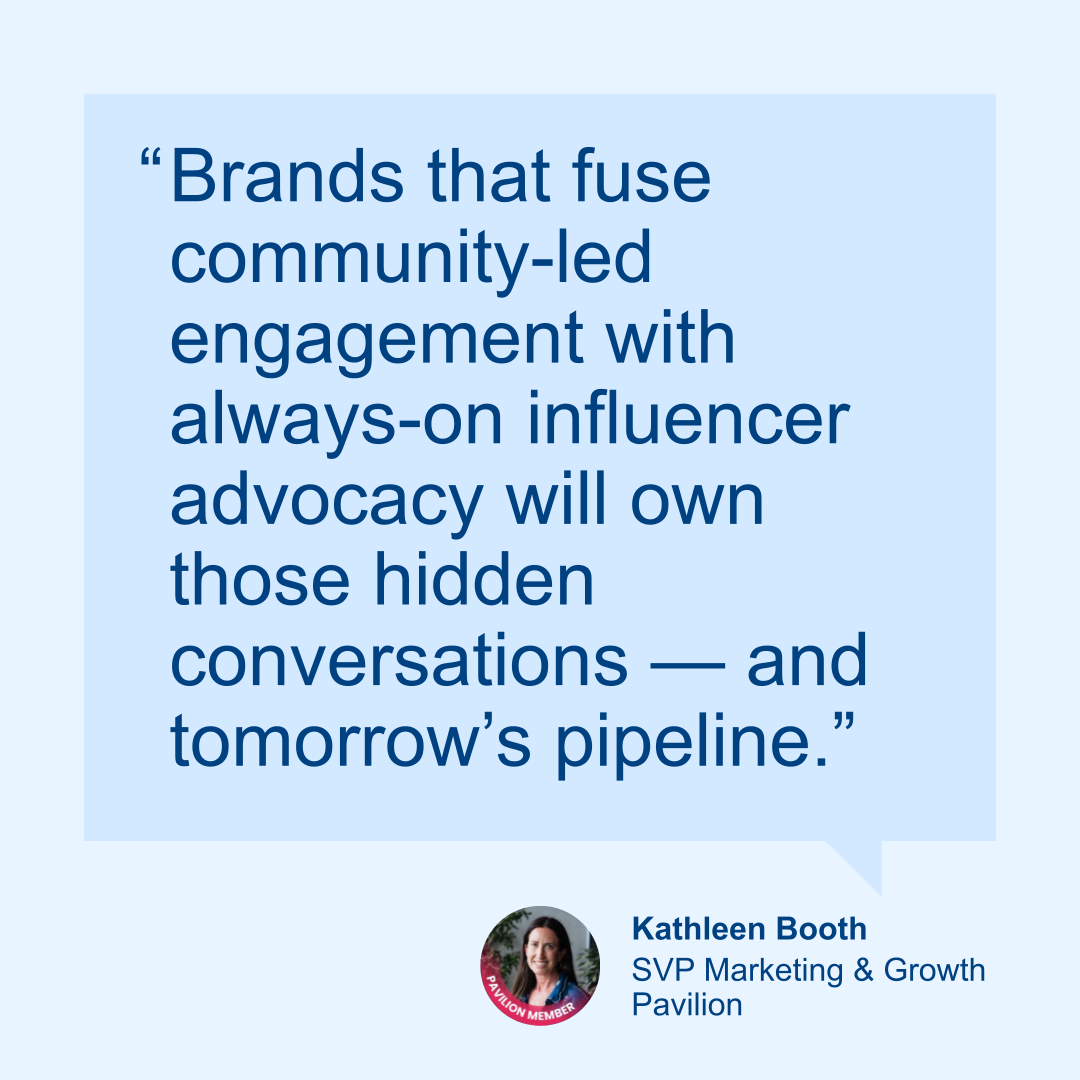
Modern B2B purchasing involves multiple stakeholders, non-linear research patterns, and conversations that happen in private Slack channels, peer communities, and informal networks. These hidden decision-making processes occur before formal evaluation begins, making traditional funnel-based attribution models increasingly inadequate for measuring true marketing impact.
The Trust Gap in B2B Marketing:
The research identifies several factors contributing to the growing importance of trust-building over traditional demand generation:
- Complex Buying Groups: Business decisions now involve an average of 6-10 stakeholders, each with different priorities and evaluation criteria. Trust building must occur across multiple personas and organizational levels. For example, while IT professionals focus on technical specifications and security, finance teams prioritize cost-effectiveness and ROI, while end-users emphasize usability and adoption ease. Marketing content must address these diverse concerns simultaneously while maintaining consistent messaging that builds trust across all stakeholder groups.
- Extended Sales Cycles: B2B sales cycles have lengthened significantly, with buyers spending 67% of their time researching independently before engaging with vendors. This extended research phase occurs primarily outside direct marketing influence. During this period, prospects consume content from multiple sources, participate in peer discussions, and form initial impressions that heavily influence final decisions. Organizations that fail to build trust during this invisible research phase find themselves excluded from consideration before formal evaluation begins.
- Information Overload: Decision-makers face overwhelming amounts of content and vendor messages, receiving an average of 121 emails per day and encountering hundreds of marketing messages across various channels. Trust acts as a filter, helping buyers identify credible sources worthy of attention and consideration. Without established trust relationships, even high-quality content gets lost in the noise, making it essential for B2B brands to build recognition and credibility before prospects need their solutions.
- Risk Aversion: B2B purchases carry significant career and organizational risks, with failed technology implementations costing companies millions of dollars and potentially damaging professional reputations. Trust reduces perceived risk by providing social proof and credible recommendations from respected sources. This risk mitigation becomes particularly critical for larger purchases or strategic technology decisions that affect multiple departments and business processes.
The study demonstrates that companies implementing trust-building strategies achieve measurable improvements across key performance indicators. Organizations leveraging creator content report 39 percentage point increases in brand awareness, 30 percentage point improvements in lead generation, and 30 percentage point growth in revenue compared to traditional approaches.
Video Marketing: The Engine of B2B Trust Building
Video has become the dominant content format for B2B marketers, with the LinkedIn research showing 78% currently implementing video strategies and 56% planning increased usage in the next year. This growth reflects video's unique ability to convey authenticity, expertise, and human connection at scale.
Performance Metrics Demonstrate Video's Impact:
Short-form social video content leads performance metrics, generating 41% ROI according to survey responses. Brand storytelling follows at 38% ROI, while testimonials and demonstrations achieve 34% return on investment. These results significantly exceed traditional content formats and demonstrate video's effectiveness for trust building.
LinkedIn's internal data supports these findings, showing B2B advertisers using video increased by 12% year-over-year. Video completions grew 34% during the same period, while view-through rates improved by 3.8 percentage points. The platform's Creative Labs analyzed over 13,000 B2B video advertisements to identify creative elements that consistently drive higher engagement rates.
Technical Specifications That Drive Performance:
The research identifies specific technical elements that impact engagement rates and trust building:
- Emotional Resonance: Videos with emotional content achieve 44% higher view-through rates and double completion rates compared to standard corporate content. Authentic storytelling that connects with viewer emotions builds stronger trust relationships. This doesn't mean B2B content should be overly dramatic, but rather should incorporate human elements like personal challenges, customer success moments, or behind-the-scenes glimpses that create emotional connections. Companies like Slack excel at this approach by showcasing real team collaboration moments rather than polished product demos.
- Format Optimization: Vertical video formats produce 34% longer dwell times compared to square-format content. This extended viewing time provides more opportunity for trust building and message delivery. Mobile consumption drives this preference, as vertical videos fill smartphone screens completely, creating more immersive viewing experiences. B2B marketers should prioritize vertical formats for social media distribution while maintaining horizontal versions for desktop and presentation contexts.
- Camera Presence: Face-to-camera presentations achieve 34% higher engagement rates. Direct eye contact and personal connection through video creates stronger trust bonds between brands and audiences. This approach works particularly well for thought leadership content, where executives or subject matter experts address industry challenges directly. The human connection established through direct camera engagement translates into higher perceived credibility and trustworthiness compared to voice-over presentations or animated content.
- Dynamic Movement: Camera movements increase engagement effectiveness by 13%. Visual variety maintains viewer attention and creates more memorable brand experiences. This includes simple techniques like slow zoom-ins during key points, smooth panning across office environments, or dynamic transitions between speakers. However, movement should serve the content purpose rather than distract from the message, with subtle motions that enhance rather than overwhelm the viewing experience.
- Color Psychology: Videos incorporating soft, tonal color palettes maintain viewer attention 20% more effectively than commercial-style color grading. Professional yet approachable visual styles support trust building objectives. Warm, natural color schemes create welcoming environments that encourage continued viewing, while harsh or oversaturated colors can create subconscious barriers to trust. Companies should develop consistent color guidelines that reflect their brand personality while optimizing for viewer retention and comfort.
The study found that 73% of video completions and 49% of engagement rates depend on creative decisions rather than production budgets or technical specifications. This finding democratizes video marketing, allowing organizations with limited resources to compete effectively through strategic creative approaches.
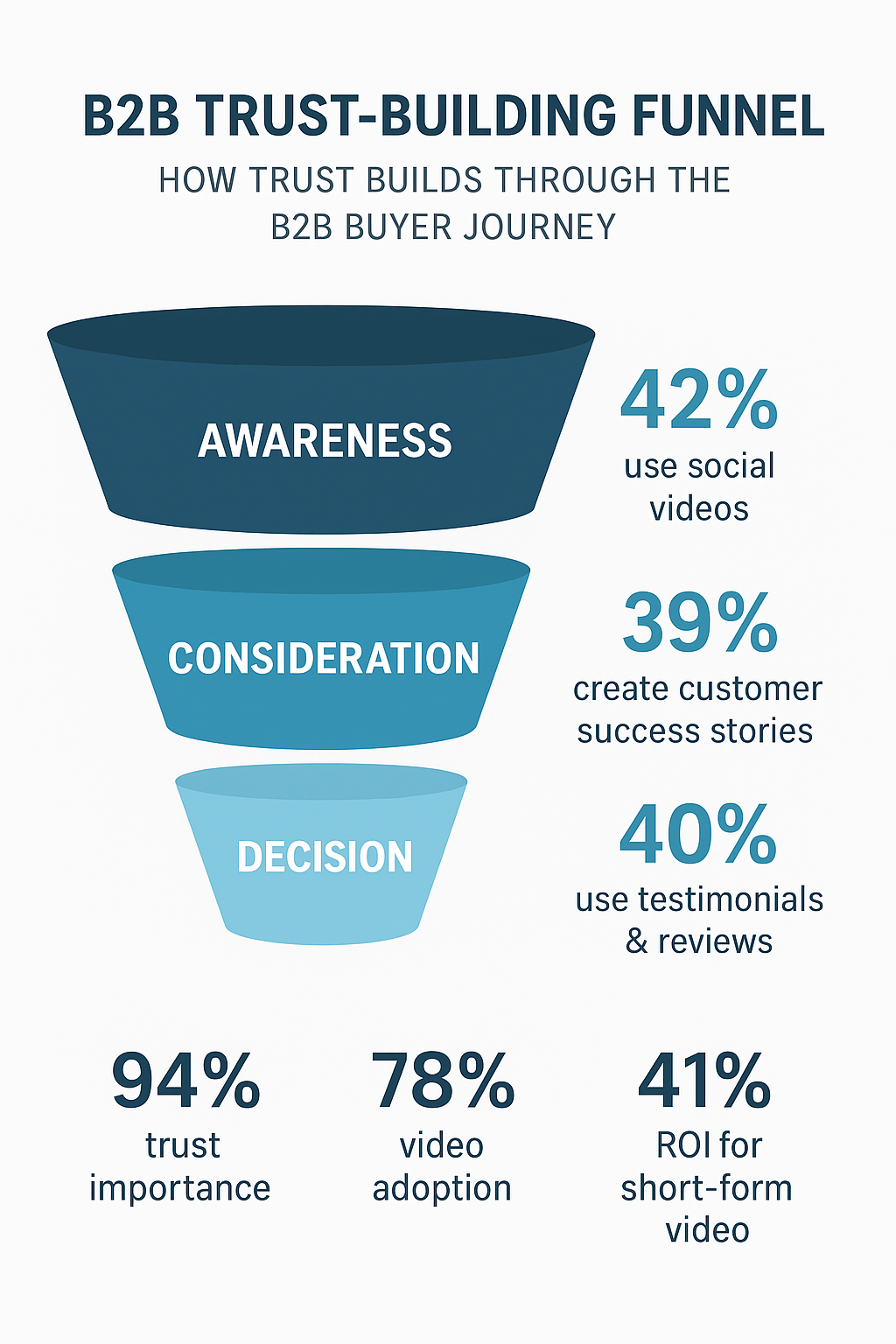
Strategic Video Content Framework for B2B Trust Building
Effective B2B video marketing requires strategic alignment between content formats and buyer journey stages. The research reveals specific strategies for different funnel levels:
Top-of-Funnel: Awareness and Initial Trust Building
At the awareness level, 42% of marketers use social media videos to drive initial interest, while 47% leverage thought leadership collaborations as effective entry points. These approaches focus on sparking attention and signaling relevance to potential buyers.
Successful top-of-funnel video content includes industry trend analysis, educational series, and expert interviews that demonstrate knowledge and authority without promotional messaging. The goal is establishing credibility and earning permission for continued engagement.
Middle-of-Funnel: Credibility and Expertise Demonstration
Middle-funnel strategies emphasize credibility building through authentic content. Customer success story videos attract 39% of marketers, while 39% co-create content with creators to build trust and engagement. Expert interviews, behind-the-scenes content, and employee spotlights provide additional options for establishing authority and expertise.
This stage requires balancing educational value with subtle product positioning. Content should address specific business challenges while demonstrating solution capabilities without aggressive sales messaging.
Bottom-of-Funnel: Proof and Decision Support
Bottom-funnel content centers on proof and decision support. Product reviews and testimonials engage 40% of marketers, while 23% utilize case study videos focused on ROI to facilitate purchasing decisions. In-depth product demonstrations and personalized content help reduce perceived risk and accelerate conversion timelines.
This content directly supports purchase decisions by providing specific evidence of value, addressing common objections, and demonstrating successful outcomes from similar organizations.
The Rise of B2B Influencer Marketing
The benchmark data shows that 55% of companies currently use influencers, with another 29% planning to adopt influencer marketing within the next year. This represents a fundamental shift in how B2B organizations approach credibility building and audience engagement.
B2B Influencer Categories and Effectiveness:
When selecting B2B creators, 58% of marketers prioritize authenticity and credibility above all other factors. Industry relevance ranks second at 49%, followed by brand alignment at 47%. This emphasis on authenticity over reach distinguishes B2B influencer marketing from consumer approaches.
The research identifies the most effective influencer categories:
- Thought Leaders and Industry Analysts (28% effectiveness rating): These individuals possess deep industry knowledge and established credibility within specific verticals. Their recommendations carry significant weight due to perceived objectivity and expertise.
- Company Customers (23% effectiveness rating): Customer advocates provide authentic testimonials and use case examples that resonate with similar organizations. Their firsthand experience reduces perceived risk for potential buyers.
- Independent Creators (20% effectiveness rating): Content creators who focus on specific business topics or industries offer authentic perspectives and often have highly engaged, niche audiences.
- Industry Partners (15% effectiveness rating): Partner organizations and complementary service providers can extend reach and provide third-party validation for solutions and approaches.
- Company Employees (14% effectiveness rating): Internal subject matter experts and executives can build personal brands that support organizational trust building while maintaining authentic voices.
Measuring B2B Influencer Impact:
The research indicates that influencer marketing delivers impact across the entire marketing funnel. Brand awareness increases by 39 percentage points when companies leverage creator content. Lead generation improves by 30 percentage points, while revenue growth achieves a 30 percentage point increase among organizations using influencer partnerships.
However, measuring influencer marketing ROI requires sophisticated attribution models that account for the complex, multi-touch B2B buying journey. Traditional last-click attribution significantly undervalues influencer contributions, which often occur early in the buyer journey and influence private conversations.
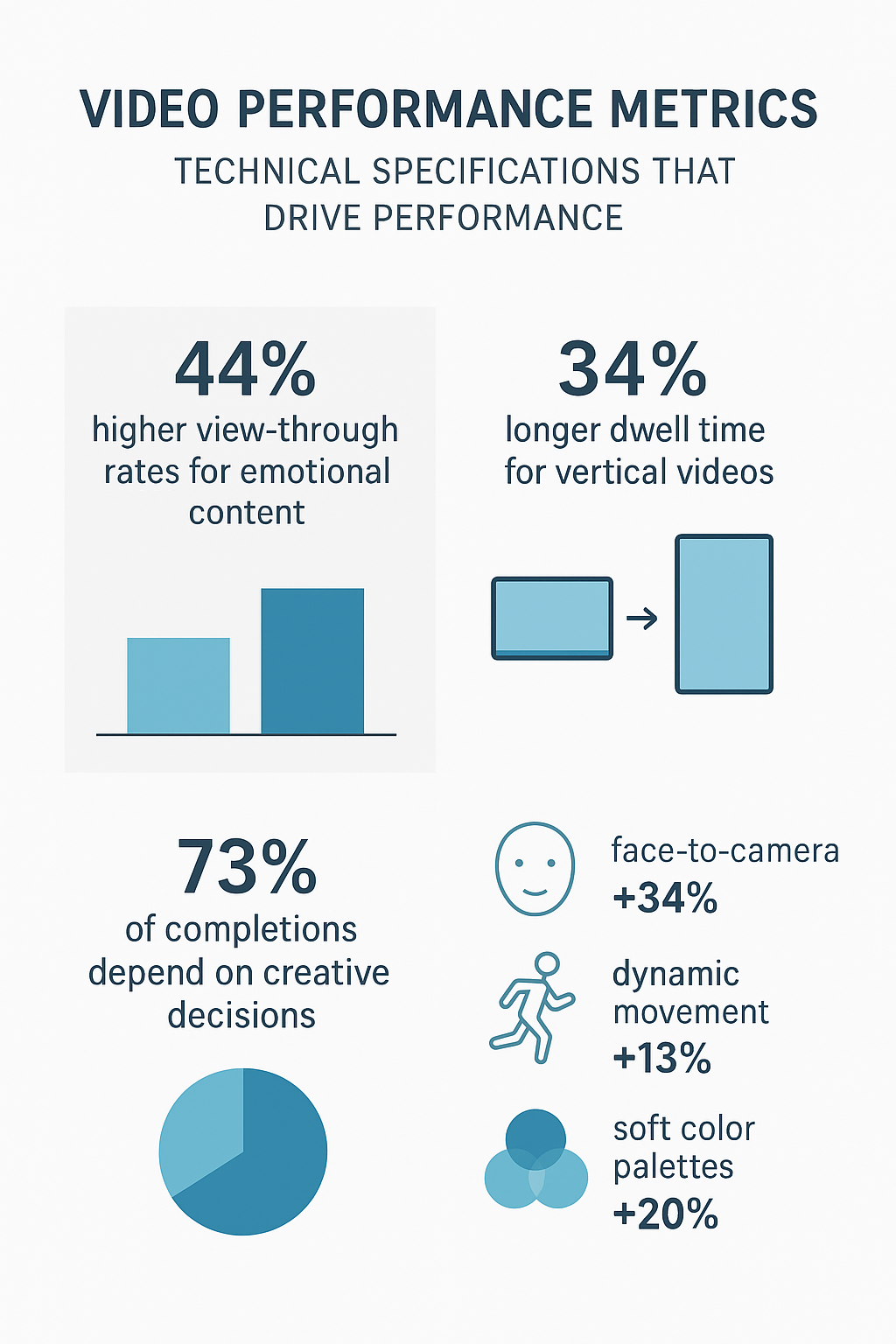
B2B Video Marketing Success Stories
Several B2B organizations have demonstrated exceptional results through strategic video and influencer marketing implementation:
HubSpot's Educational Content Strategy:
HubSpot has built a comprehensive video marketing engine that combines educational content with thought leadership positioning. Their approach includes:
- HubSpot Academy: Over 1,000 video courses that provide genuine educational value while subtly demonstrating platform capabilities. This approach builds trust through knowledge sharing rather than direct promotion.
- Executive Thought Leadership: CEO and executive video content that addresses industry trends and challenges, establishing leadership credibility while supporting brand positioning.
- Customer Success Stories: Detailed case study videos that showcase specific results and methodologies, providing proof points for prospective customers facing similar challenges.
HubSpot's video content generates millions of views and drives significant lead generation while building long-term trust relationships with their target audience.
Salesforce's Trailblazer Community Approach:
Salesforce has created one of the most successful B2B community-driven content strategies through their Trailblazer program:
- User-Generated Content: Customer and partner-created video content that showcases real-world implementations and success stories. This approach leverages authentic customer voices to build trust.
- Expert Interviews: Regular video interviews with industry experts and customers that provide insights into best practices and emerging trends.
- Event Content: Comprehensive video coverage of Dreamforce and other events that extends reach and provides valuable content for those unable to attend in person.
This community-centric approach has helped Salesforce maintain market leadership while building deep trust relationships across their customer base.
LinkedIn's Own Video Marketing Excellence:
LinkedIn practices what they preach through sophisticated video marketing that combines platform capabilities with authentic content:
- Executive Positioning: CEO Ryan Roslansky's regular video updates provide transparency and thought leadership that builds trust with both users and advertisers.
- Educational Series: LinkedIn Learning and other educational video content that provides genuine value while demonstrating platform understanding of user needs.
- Customer Success Documentation: Detailed video case studies that showcase advertiser success and provide proof points for platform effectiveness.
LinkedIn's integrated approach demonstrates how video content can support multiple business objectives while maintaining authenticity and trust.
Advanced Metrics and Measurement Strategies
The research reveals that 26% of marketers identify ROI measurement as a primary concern when implementing video and influencer strategies. Traditional measurement approaches often fail to capture the full impact of trust-building activities, which influence hidden conversations and group decision-making processes.
Multi-Touch Attribution Models:
Effective B2B video marketing measurement requires sophisticated attribution models that account for:
- Extended Sales Cycles: B2B purchases often involve months or years of research and evaluation. Video content consumed early in this process influences final decisions even when direct attribution is impossible.
- Multiple Stakeholders: Different team members consume different content types and influence decisions in various ways. Measurement systems must account for this complexity.
- Private Conversations: Much of the decision-making process occurs in private channels and meetings. Video content that builds trust influences these hidden conversations.
Advanced Performance Indicators:
Beyond traditional metrics like views and engagement, B2B video marketing requires measurement of:
- Brand Sentiment Analysis: Monitoring changes in brand perception and sentiment across social media, review sites, and industry publications.
- Share of Voice: Tracking brand mention frequency and context compared to competitors across various channels and content formats.
- Influence Network Analysis: Measuring how content spreads through professional networks and influences key decision-makers within target organizations.
- Sales Cycle Impact: Analyzing how video consumption affects deal velocity, size, and closure rates across different buyer journey stages.
Trust Measurement Frameworks:
The benchmark report introduces three strategic frameworks to help marketers operationalize trust-building measurement:
- Trust Flywheel: Demonstrates how video, influencers, and credible content work together to build momentum that accelerates over time.
- Trust Maturity Index: Benchmarks organizational progress from early-stage experimentation to fully integrated trust systems that drive consistent results.
- Trust Funnel: Maps trust-building content to specific stages of the buyer journey, enabling more precise measurement and optimization.
These frameworks provide structured approaches for measuring trust-building activities and connecting them to business outcomes.
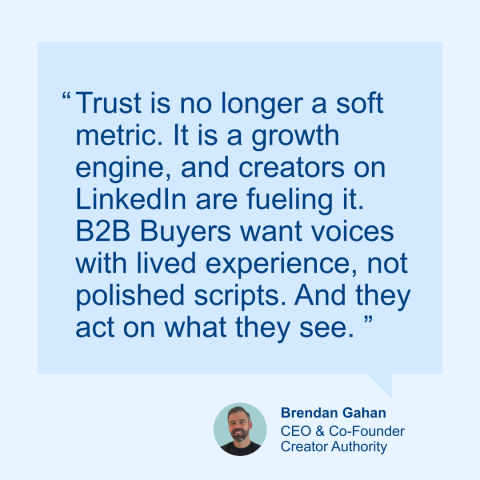
Platform-Specific Strategies and Best Practices
Different social media and video platforms require tailored approaches for B2B trust building:
LinkedIn Video Marketing:
As the primary professional networking platform, LinkedIn offers unique advantages for B2B video marketing:
- Native Video Content: LinkedIn's algorithm favors native video content, providing increased organic reach compared to external links or traditional posts.
- Professional Context: Users are in a business mindset when consuming LinkedIn content, making them more receptive to B2B messaging and thought leadership.
- Targeting Capabilities: Sophisticated targeting options allow precise audience selection based on job title, industry, company size, and other professional criteria.
Best practices for LinkedIn video include keeping content under 60 seconds, adding captions for accessibility, and focusing on professional insights rather than promotional messaging.
YouTube for B2B:
YouTube's search functionality and long-form content capabilities make it ideal for educational and demonstration content:
- SEO Benefits: Video content on YouTube ranks in both YouTube and Google search results, extending organic reach and visibility.
- Long-Form Content: The platform supports detailed tutorials, webinars, and comprehensive product demonstrations that build deep trust through education.
- Playlist Organization: Organized content series help viewers navigate complex topics and build progressive understanding.
Successful B2B YouTube strategies focus on solving specific business problems through detailed, helpful content that positions brands as trusted advisors.
Emerging Platforms and Formats:
While LinkedIn and YouTube dominate B2B video marketing, other platforms offer opportunities for reaching specific audiences:
- Instagram and TikTok: Increasingly used by younger B2B professionals, these platforms require adapted content strategies that balance professional insights with platform-native formats.
- Podcast Video: The growth of video podcasts creates opportunities for long-form thought leadership content that builds deep trust relationships.
- Virtual and Augmented Reality: Early adopters are exploring VR and AR for product demonstrations and immersive brand experiences.
Budget Allocation and Resource Planning
Budget trends demonstrate increasing investment in trust-building activities. The study shows that 42% of marketers rank increasing brand awareness and reputation among decision-makers as their top business priority, surpassing traditional demand generation objectives.
Investment Priorities for 2025:
Most B2B marketers are increasing their video output, with 56% planning higher production volumes and 43% intending to boost influencer investment next year. This expansion requires strategic budget allocation and leadership support to scale efforts effectively.
Recommended budget allocation frameworks include:
- 70-20-10 Rule: 70% of video marketing budget for proven formats and channels, 20% for emerging opportunities, and 10% for experimental approaches.
- Content Type Distribution: Balanced investment across top-funnel awareness content (40%), middle-funnel credibility building (35%), and bottom-funnel decision support (25%).
- Production vs. Distribution: Strategic balance between content creation costs (60%) and promotion/distribution expenses (40%) to ensure content reaches target audiences.
Team Structure and Collaboration:
Companies implementing cross-functional collaboration around video and influencer campaigns report higher success rates. The research indicates that organizations involving Content, Brand, Analytics, and Sales teams in campaign planning and execution achieve more consistent messaging and full-funnel support.
Successful B2B video marketing requires:
- Content Strategy Leadership: Senior-level ownership of content strategy and trust-building objectives with clear connections to business outcomes.
- Cross-Functional Teams: Regular collaboration between marketing, sales, customer success, and product teams to ensure authentic, relevant content creation.
- Technical Capabilities: Investment in video production tools, editing capabilities, and distribution technology to support consistent, high-quality output.
- Performance Analysis: Dedicated resources for measurement, optimization, and reporting that connect video marketing activities to business results.

Industry-Specific Considerations
Different B2B industries require tailored approaches to video marketing and trust building:
Technology and Software:
Technology companies benefit from demonstration-heavy content that showcases product capabilities and use cases:
- Product Demos: Detailed walkthroughs that highlight specific features and benefits while addressing common user questions.
- Customer Implementation Stories: Real-world examples of successful deployments and the business results achieved.
- Technical Education: Complex topics broken down into accessible formats that build authority and trust among technical decision-makers.
Financial Services:
Financial services require particular attention to compliance and trust building:
- Thought Leadership: Industry trend analysis and regulatory insights that demonstrate deep market understanding.
- Client Testimonials: Carefully curated success stories that comply with regulatory requirements while providing social proof.
- Educational Content: Complex financial concepts explained in accessible formats that build credibility and trust.
Professional Services:
Consulting and professional services firms leverage video to demonstrate expertise and build personal connections:
- Case Study Presentations: Detailed project walkthroughs that showcase methodology and results without compromising client confidentiality.
- Industry Insights: Regular commentary on market trends and challenges that positions firms as trusted advisors.
- Team Introductions: Personal videos that help prospects connect with individual team members and build relationship foundations.
Manufacturing and Industrial:
Manufacturing companies use video to showcase complex products and capabilities:
- Facility Tours: Behind-the-scenes content that demonstrates manufacturing capabilities and quality processes.
- Product Applications: Real-world usage scenarios that help buyers understand practical applications and benefits.
- Safety and Compliance: Documentation of safety procedures and compliance measures that build trust in product quality.
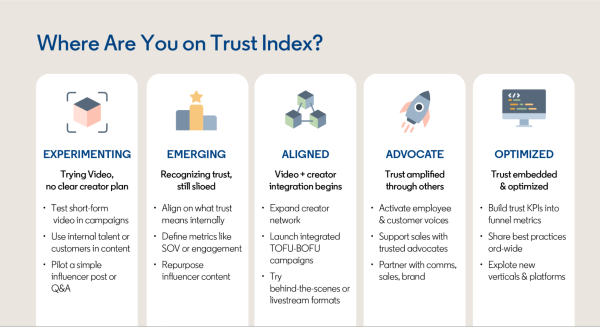
Future Trends and Emerging Technologies
The B2B video marketing environment continues evolving rapidly, driven by technological advancement and changing buyer expectations:
Artificial Intelligence Integration:
AI technologies are transforming video creation, personalization, and optimization:
- Automated Video Creation: AI-powered tools enable rapid creation of personalized video content at scale, allowing customization for specific industries, roles, or companies.
- Performance Optimization: Machine learning algorithms analyze video performance data to identify optimal formats, timing, and content elements for specific audiences.
- Personalization at Scale: Dynamic video content that adapts to viewer characteristics and behavior patterns, creating more relevant and engaging experiences.
Interactive Video Experiences:
Interactive video formats create more engaging experiences that support trust building:
- Clickable Elements: Videos with embedded links, forms, and interactive elements that allow viewers to access additional information without leaving the content.
- Choose-Your-Own-Adventure: Branching video narratives that allow viewers to select topics or information most relevant to their needs.
- Real-Time Engagement: Live streaming capabilities that enable direct interaction between brands and audiences, building immediate trust through authentic conversation.
Advanced Analytics and Attribution:
Measurement capabilities continue advancing to provide better insights into video marketing impact:
- Cross-Platform Tracking: Unified measurement across multiple platforms and touchpoints to provide comprehensive view of video content performance.
- Behavioral Analysis: Advanced analytics that connect video consumption patterns to subsequent business actions and outcomes.
- Predictive Modeling: AI-powered analysis that predicts which video content and formats will drive desired business outcomes for specific audience segments.
Implementation Roadmap for B2B Organizations
Organizations seeking to implement comprehensive video and influencer marketing strategies should follow a structured approach:
Phase 1: Foundation Building (Months 1-3)
- Audit Current Content: Evaluate existing video content and identify gaps across buyer journey stages.
- Define Trust Metrics: Establish baseline measurements for brand awareness, sentiment, and trust indicators.
- Identify Internal Experts: Catalog subject matter experts and potential employee advocates who can create authentic content.
- Platform Assessment: Evaluate platform options and select 2-3 channels for initial focus.
Phase 2: Content Development (Months 4-6)
- Create Content Calendar: Develop 6-month content plan aligned with buyer journey stages and business objectives.
- Produce Pilot Content: Create initial video series to test formats, messaging, and audience response.
- Establish Production Workflow: Implement processes for content creation, review, and distribution.
- Launch Influencer Partnerships: Begin relationships with industry thought leaders and customer advocates.
Phase 3: Scale and Optimize (Months 7-12)
- Expand Production: Increase content volume based on performance insights and audience feedback.
- Advanced Measurement: Implement sophisticated attribution models and trust measurement frameworks.
- Cross-Functional Integration: Align video marketing with sales processes and customer success programs.
- Continuous Optimization: Regular analysis and refinement based on performance data and market feedback.

Conclusion: The Trust-First Future of B2B Marketing
The research demonstrates conclusively that trust has become the primary driver of B2B marketing success. Organizations that recognize this shift and invest in authentic, valuable video content will build sustainable competitive advantages through stronger relationships and enhanced credibility.
The 78% adoption rate for B2B video marketing represents just the beginning of this transformation. As buyers continue spending more time researching independently and making decisions through private conversations, the ability to build trust at scale becomes increasingly critical for business success.
Video content and strategic influencer partnerships provide the most effective mechanisms for building this trust. However, success requires moving beyond traditional demand generation thinking toward systematic trust-building approaches that account for complex buying group dynamics and extended decision-making processes.
The organizations that master this transition will not only achieve superior marketing performance but will build lasting relationships that drive sustained business growth. The trust revolution in B2B marketing has begun—the question is whether your organization will lead or follow.
By implementing the strategies and frameworks outlined in this guide, B2B marketers can transform their approach from transaction-focused demand generation to relationship-building trust development. This shift requires investment, commitment, and patience, but the research demonstrates that organizations making this transition achieve measurable improvements in brand awareness, lead generation, and revenue growth.
The future belongs to B2B brands that recognize trust as their most valuable asset and invest accordingly in building it through authentic, valuable video content and credible influencer partnerships. The data is clear—trust is not just important for B2B marketing success, it is the foundation upon which all other marketing activities must be built.
%20-%20Alternate.svg)
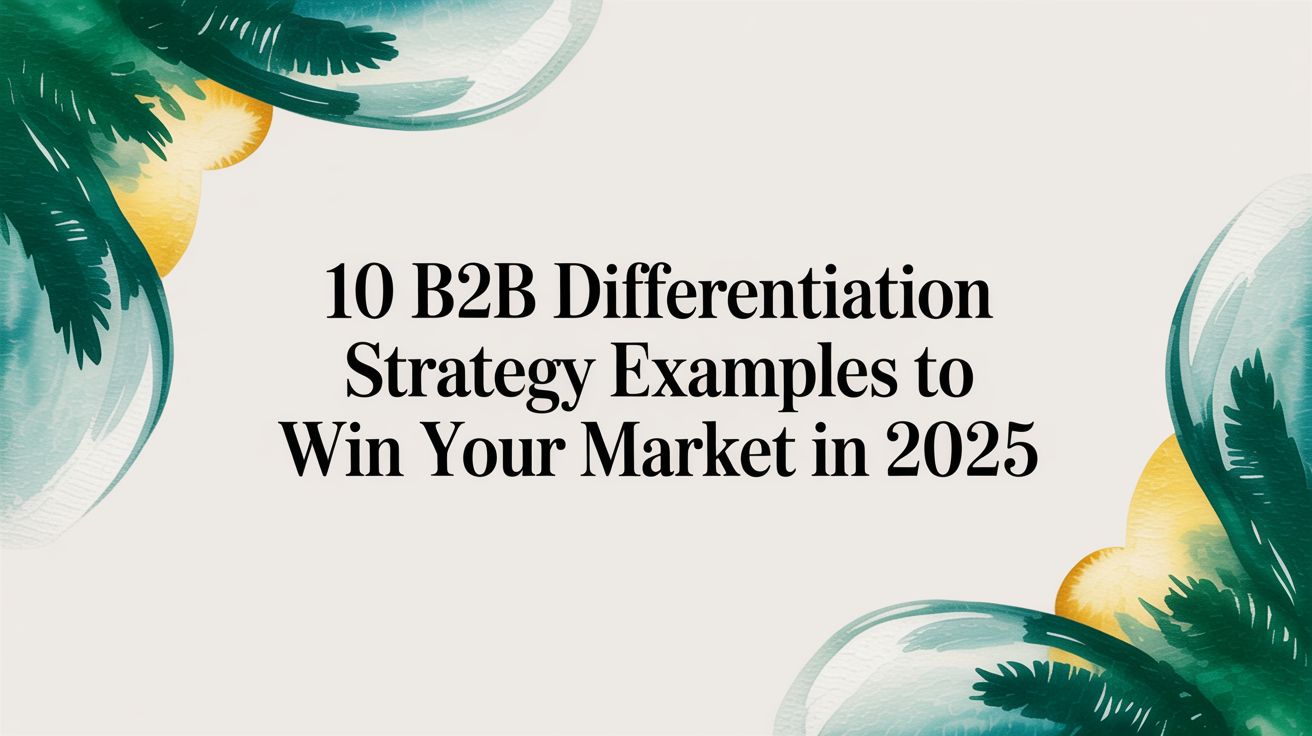
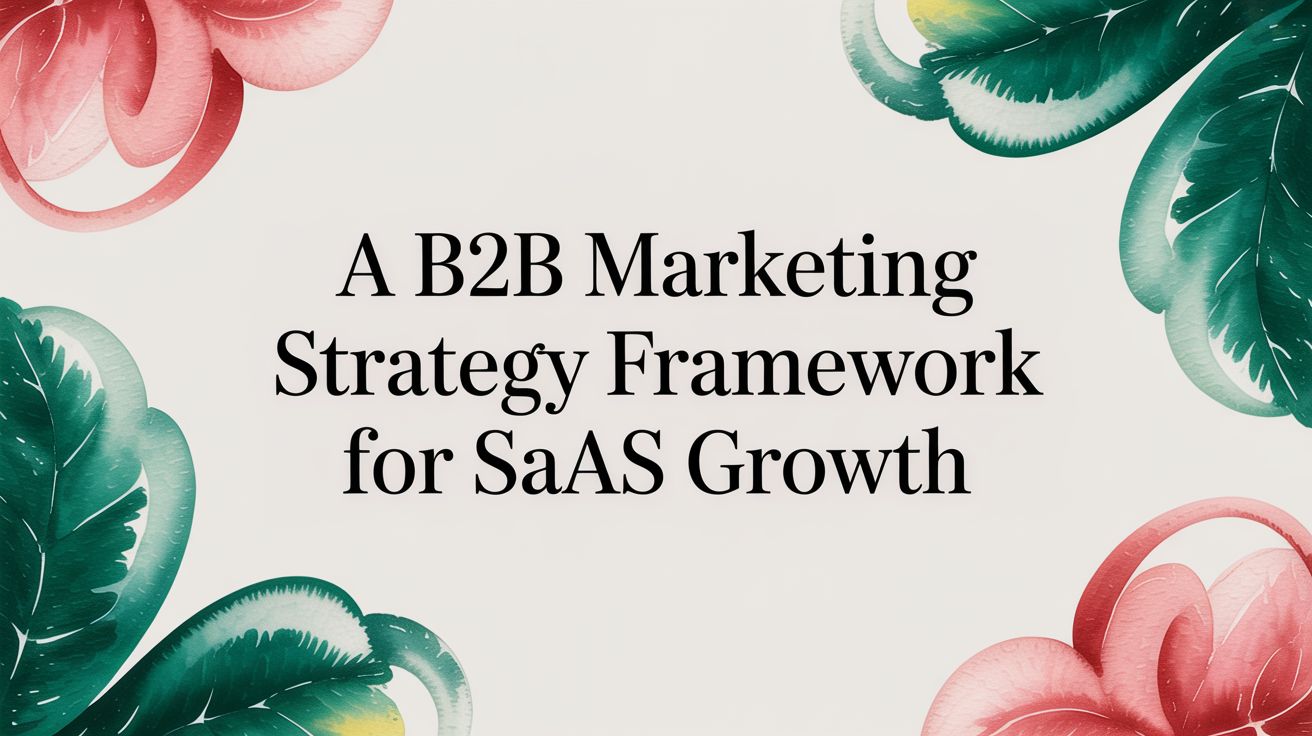
%20-%20white.svg)